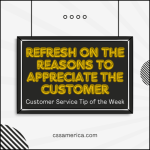Imagine being a customer walking down an aisle in your home improvement store, and employees are lining the aisle…clapping for you! You know what I call that? Unrealistic.
Maybe you’re a customer walking down a hallway at a hotel, and employees are lining the hallway…clapping for you! You know what I call that? A reality.
That’s what happened to school employees at a Ritz-Carlton in Atlanta, GA. According to the article Enota 1 of 4 honored by state for welcoming families, “A line of Ritz-Carlton employees stretched down the hotel hallway, and applause erupted as a group of public school educators walked by.” Apparently, the hotel occasionally uses the “wall of applause” to convey appreciation for its customers.
So if employees clapped for you, how would you feel (besides “awkward”)? Would you feel appreciated? Valued? Special?
The article notes that “With research showing a clear link between parent engagement and student success, education officials say it’s essential that parents are involved, and they must make sure families feel welcome at schools that can sometimes feel like fortresses.”
Many schools are becoming even notorious for loading down parents with early school year paperwork, requests to follow teachers and the school on Twitter, Facebook, e-mail distribution lists, etc. Demands on parents are increasing, and much of this is for the better (to encourage more parental involvement, better communications, safety, etc.). But when you ask your “customer” to do more, at some point you need to show appreciation for that involvement, for that effort, for that reciprocal communication.
Think about what you ask of your customers, particularly if that customer has few alternatives for your services (K-12 schools and local government, for example).
Then identify ways to convey appreciation for involvement, thereby encouraging positive customer behaviors to continue.
Learn about our CSS Education services at: http://cssamerica.com/cssed.htm
Interested in improving your educational organization’s parent/community satisfaction? See our other blog posts at: http://serviceadvice.cssamerica.com/category/education/





















